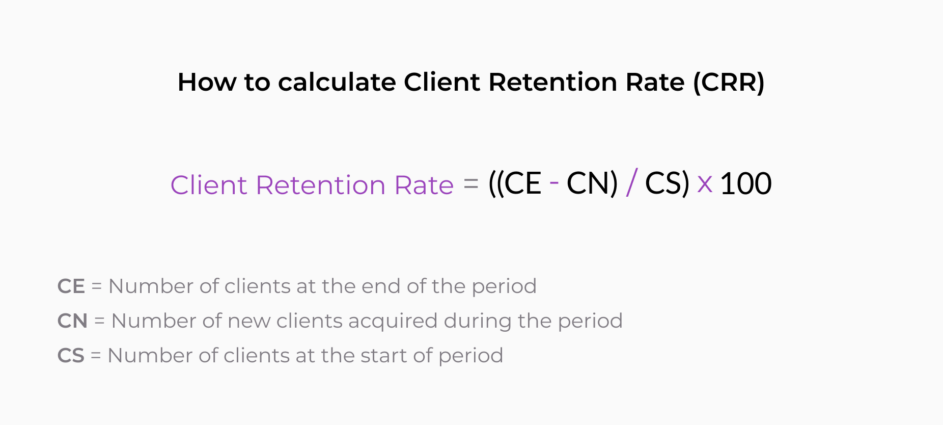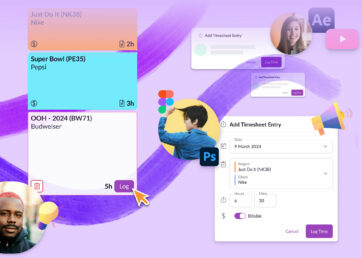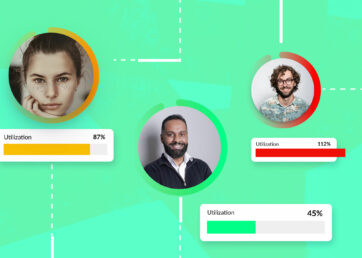Have you mastered the art of acquiring new clients for your agency? That’s only half the battle. Retaining clients is where many agencies slip up, missing out on consistent revenue through lasting client relationships.
A 5% increase in customer retention can boost profitability by as much as 75%. Thankfully, your agency doesn’t have to be the one to miss out on all the benefits of client retention done well.
In a world where clients can switch agencies at the drop of a hat, your ability to retain clients is as crucial as your ability to attract them. That’s why we spoke to an agency subject matter expert, to give you real-world insight into all things client retention for agencies.
In this article 📖
What is agency client retention?
The agency client retention process involves keeping clients engaged and satisfied long-term. It’s the practice of building lasting agency-client relationships to ensure they continue doing business with your agency.
Client acquisition vs. client retention
Client acquisition focuses on attracting new clients, and is often expensive and time-consuming. It typically requires that you invest heavily in marketing campaigns and sales efforts to win a new client.
Client retention focuses on nurturing current clients, and is often more cost-effective because you’re capitalizing on an existing relationship. With client retention, you’ve already done the hard work of winning the client. Now it’s about keeping them happy, delivering on promises, and exceeding expectations.
This doesn’t mean you should ignore client acquisition. But it does mean a balanced strategy that leans on strong retention practices matters.
How to calculate agency client retention rate
Calculating your agency’s client retention rate is straightforward. Use this simple formula:
Client retention rate = ((Number of clients at end of the period – Number of new clients acquired during the period) / Number of clients at the start of period) x 100

This formula gives you a percentage that represents your client retention rate for a specific time frame, such as a quarter or a year. The formula comes in handy when you need to isolate the impact of your retention efforts from your acquisition activities.
By excluding new clients acquired during the period, you focus solely on how well you’ve retained existing clients. A higher percentage indicates strong retention, while a lower one signals that you may need to invest more in keeping clients satisfied.
Let’s see what this looks like in practice.
Suppose an agency starts the month with 50 clients. By the end of the month, the agency had 55 clients, with 10 new clients acquired.
Using the formula, it would look like this:
((55 – 10) / 50) x 100 = 90%
This shows that the agency retained 90% of its clients for that month, a great retention rate!
With that said, let’s take a look at what makes for a good agency client retention rate.
What is a good agency client retention rate?
A good retention rate for you will vary based on your agency’s retention goals. However, there are also some general benchmarks that can help you pinpoint a healthy rate.
There are lots of different agency customer retention rate (CRR) data out there taken by industry or even client contract type.
Let’s look at a few.
Retainer vs. project-based contracts turnover rates
According to Sakas and Company, an agency support and training program, if you’re operating a retainer-oriented agency, a client turnover higher than 20% is a red flag. In such cases, it suggests that a significant portion of your client base is at risk, affecting your client retention rate significantly.
On the other hand, project-based agencies might experience client turnover rates between 30-50%, which is more acceptable as long as there’s a robust sales pipeline for new acquisitions. While this is common, agencies should still investigate why it happens and how it impacts their client retention not just on a project basis, but across the board.
When it comes to retainer vs. project-based contracts, the former usually boasts higher retention rates. That’s because retainer contracts often foster deeper, more committed relationships between agencies and clients.
It’s also common for larger clients to work on a retainer basis, which makes the onboarding process harder, possibly more expensive, and more time-consuming. As a result, switching agencies is more difficult.
Client concentration
Keep in mind that the issue of client concentration can also skew these numbers. For example, if one client makes up more than 20% of your business, losing that client can have a major impact on your revenue.
Client retention rates are not a one-size-fits-all measure. It’s why agencies should aim for a rate tailored to their business model, whether it’s retainer-based or project-based, while also being mindful of client concentration and its potential to skew retention percentages.
Client retention rates across industries
According to research from Exploding Topics, CRR varies widely by industry, with professional services and media leading the way at 84%.
These industry retention rates could be a good indicator for your agency, depending on what your agency and your agency clients specialize in.

Source: Exploding Topics
- Media companies: 84%
- Professional services: 84%
- Automotive & Transportation: 83%
- Insurance: 83%
- IT services: 81%
- Construction & Engineering: 80%
- Financial services: 78%
- Telecommunications: 78%
- Healthcare: 77%
- IT & software: 77%
- Banking: 75%
- Consumer services: 67%
- Manufacturing: 67%
- Retail: 63%
- Hospitality, travel, restaurants: 55%
Now, if you take the average of retention rates across industries, CRR generally ranges from 75-80%.
While this is a more general rate, it can help set the context of what you can expect when you focus on retaining clients rather than only acquiring new ones.
6 benefits of having strong agency client retention rates
You’ve already won the client—why not take the time to keep them? This cost-efficiency directly contributes to your bottom line. But that’s hardly the only benefit of establishing a strong agency client retention strategy.
1. Boost your revenue
Loyalty360 reports an average of 68% of new business comes from current customers. This means high retention rates often translate to consistent revenue streams. It can also cost five times more to attract a new customer than it is to keep an existing one.
2. Get client referrals from satisfied clients
Let’s not forget the power of client referrals. Satisfied clients don’t just stay—they also become brand advocates who bring new business to your doorstep. As fiercely competitive as agencies are, word-of-mouth client acquisition becomes that much more valuable.
3. Create a predictable workload
When your agency has a strong client retention rate, it makes workload planning a lot easier. Why? It allows for efficient resource planning helping you allocate the right talent to the right projects without the stress of constant client churn. Predictable workloads also decrease the risk of resource underutilization, as you’re not caught off guard by sudden drops in client numbers.
4. Increase team knowledge and expertise
Retaining clients for extended periods allows your team the opportunity to accumulate valuable, industry-specific knowledge and expertise. This isn’t just beneficial for the client you’re currently serving—it enriches your agency’s general expertise, making you more competitive and better equipped to serve future clients.
5. Create account expansion opportunities
When you keep clients around, you get the chance to deepen those relationships. This not only makes collaboration easier but also helps in foreseeing and preventing issues before they turn into problems that could jeopardize the account.
Key agency roles like account and project managers benefit from strong long-term relationships because they’re better able to anticipate needs and upsell clients.
6. Maintain agency reputation
A low CRR doesn’t just deprive you of stable revenue, but you also risk damaging your agency’s reputation. A cycle of short-lived client relationships suggests a failure to deliver, making it harder to attract new business. Word of mouth can work both ways here. Focusing on client retention helps ensure your agency is notorious for all the right reasons!
Reasons why agency clients leave
About 40% of brands are likely to part with their agency within six months of working together. Setup, a company that provides services for brands and agencies to reach their full potential, published its annual agency client survey and highlighted some of the main issues that surfaced by clients in 2022.
“Clients want their Agencies to be more professional, collaborative, transparent, and strategic. They want them to have a deeper understanding of their business and to provide better value. If Agencies don’t show up in these ways, Clients will end the relationship and find a new partner.”
Consider a few more of the most common reasons why clients leave:
Unmet expectations
Clients leave when you don’t deliver what you promise. Setup also reveals key reasons for clients leaving agencies as: client dissatisfaction with strategic approaches, and changes in agency leadership and personnel
Miscommunication is fertile ground for misunderstandings and frustrations. Agency account managers must keep lines of communication open and clear.
Don’t make your client feel like just another number on your roster. Be sure to take the time to communicate clearly and consistently. Always make sure you’re on the same page about project goals and deliverables.
Scope misalignment
A well-defined project scope helps agencies manage client expectations and prevent misunderstandings. All too often, projects derail due to lack of project scope, or scope creep sneaks up out of nowhere, jeopardizing the client relationship.
Inconsistent quality
Clients expect consistent, high-quality work. A dip in quality signals unreliability, prompting clients to look elsewhere.
This is where a few elements can be lifesavers:
- Workflows: The sequence of end-to-end activities that see your project to completion.
- Agency processes: An established framework your team uses to complete high-quality work on time.
- SOPs: Standardized procedures your agency uses to complete routine tasks.
High costs, low value
According to agency-specific research by Digiday, 77% of marketers have decided to part with agencies because of underperforming or low-quality campaigns. AdAge cites a perceived lack of strategy as yet another big reason clients decide to stop working with ad agencies.
When clients feel they’re not getting a good return on their investment, they’ll start shopping around. This is a critical concern for agency resource managers who are often in charge of budget management.
Ignored feedback
Agencies that don’t act on client feedback miss a golden opportunity for improvement. Listening and adapting are essential qualities of project managers, as they develop client relationships and get intimately familiar with client challenges.
Lack of transparency
Clients want to know what’s happening with their projects. Agency resourcing managers can mitigate this issue by effectively allocating resources and keeping clients in the loop.
Being able to account for how clients are being charged and for what goes a long way in ensuring clients feel like they’re being treated fairly and that they’re getting exactly what they signed up for.
This is where indispensable tools like activity tracking and appointment scheduling within management tools like Resource Guru can make a difference in client management processes.
Inadequate problem-solving
When issues arise—and they will—the ability to resolve them swiftly and correctly is crucial. Failure to do so falls squarely on leadership and project managers concerned about retention.
Understanding these common reasons can help you take proactive steps to improve client retention and avoid the painful, costly experience of losing valuable clients. So make sure to get familiar with how you’re handling the client experience from end to end.
Signs a client is about to break up with your agency
How do you know if your client is planning on breaking ties with you and saying goodbye? Consider some telltale signs:
Reduced communication: When clients suddenly become less responsive or avoid meetings, take it as a warning sign. They might be disengaging.
Frequent complaints: A spike in complaints or negative feedback indicates dissatisfaction. Address these concerns immediately if possible. Aim to over-communicate instead of quietly hoping things work out on their own.
Decline in engagement: If a client stops participating in discussions or providing input, they may be losing interest in your services. Be sure to touch base with them regularly , at a cadence that makes sense for both parties.
Delayed payments: Consistently late payments can signal financial discontent or a loss of trust in the value you provide. Consider opening communication around payment delays and any existing concerns. It’s always better to go off facts in situations like these rather than assumptions.
Change in personnel: A new decision-maker on the client’s team may seek to make changes, which could include switching agencies. Clients will often answer messages and emails later than usual when this happens.
Short-term focus: If a client shifts from discussing long-term goals to only short-term projects, they may be planning an exit strategy. While this may be due to a number of valid reasons, it’s important to get clear on what those are.
Competitive research: When clients start asking about your competitors, what makes you different from other agencies, or industry pricing, they might be comparing options.
8 strategies and tips to improve agency client retention
We recently had the pleasure of chatting with Kinga Edwards, the founder of agency brainybe.es, to dive deep into agency client retention strategy.
Here are our favorite takeaways:
1. Be a partner, not just a provider
“The key to retaining clients is about building a partner base instead of just collecting clients like Pokemon. They let you feel great when they feel you are their partner.”
Build a relationship that extends beyond just completing tasks and sending invoices. Be an integral part of your client’s growth journey.
2. Invest in resource management tools
For agency client retention, resource management isn’t just a logistical requirement but a vital part of creating value for clients and fostering long-term relationships.
That’s why investing in a purpose-built resource management tool from day one will pay off in the long run.
3. Don’t overcharge your clients
Kinga shares that her agency doesn’t charge clients for every interaction, which is where accurately tracking billable and non-billable hours is essential. “Whether it’s tackling small tasks at no extra cost, offering complimentary services, or recommending a superior solution, we’re all in,” she said.
“We invest in building meaningful relationships. We’re passionate about what we do, and that’s something you can’t put a price tag on.”
4. Blend technology and human skills for capacity planning
Kinga sees this approach to capacity planning as cooking the perfect soup. “It’s a blend of technology, people, SOPs, and innovation,” she said. This ‘soup’ keeps their team organized and on track, which translates into top-notch client service.
5. Be cautious with client referral programs
On the topic of client referral programs, Kinga had a nuanced take. While she sees these programs as highly effective when well executed, they can be risky.
“The short-term gains of a client referral program can sometimes lead to long-term headaches, especially if the relationship sours, or the deal isn’t renewed,” she warned.
Make sure both parties are comfortable with the arrangement and the incentives given.
6. Maintain high communication standards
Communication stood out as a pivotal element in Kinga’s agency’s success. Kinga highlighted the agency’s work schedule, which allows for flexibility and high standards in communication.
“Being proactive, not reactive, is the key,” she said, emphasizing that good communication is integral both internally and with clients. Also being proactive and available across different time zones enriches client interaction and internal team dynamics.
7. Look beyond numbers for ROI
Metrics are important, but genuine client satisfaction, referrals, and positive feedback also serve as key indicators of your success in client retention.
As for her agency, Kinga doesn’t just focus on numbers. “For us, ROI isn’t just a number. It’s the positive feedback, the referrals, and the kind words from our clients,” she shared.
While it may sound cliche, it’s the heartbeat of her client retention philosophy.
8. Don’t neglect client retention for acquisition
According to Kinga, many agencies are so fixated on client acquisition that they completely overlook the importance of client retention.
“They hire sales managers and outreach specialists, but they have nobody in their customer success team, and their account managers are on vacation. Always,” she said.
Manage your agency’s client retention rates with ease
Excellent client retention ties back into efficient resource management. But more than that, it takes a thoughtful approach to delivering results.
When you manage your resources well, whether we’re talking about human talent, time spent on acquiring new vs. nurturing existing customers, or your agency tech stack, you set your agency up to not just meet—but exceed—client expectations.
There’s a lot that goes into excellent client retention rates—so why do it alone when tools like Resource Guru make resource management, tracking billable hours, and assigning resources easier?
Take the first step toward better client retention—get started with Resource Guru today.





